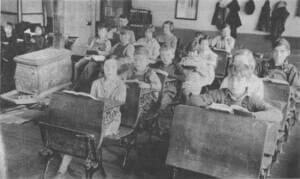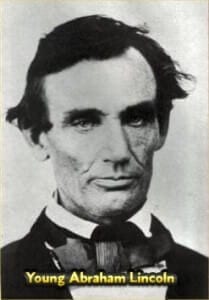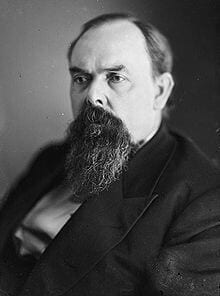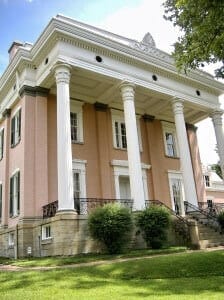Indiana Education and Religion
Although the Indiana Constitution called for the establishment of “a general system of education, ascending in a regular graduation, from township schools to a state university, as soon as circumstances will permit,” there was no formal system of education before 1851, when a new state constitution was adopted.
 Schools that were built before 1851 were funded by the county, city, or township they occupied. Many of these early schools charged tuition. Churches and individuals maintained many good private schools, but they were generally not free (i.e. Notre Dame). The Quakers probably had the best elementary schools, while many ministers, especially Presbyterians, taught schools.
Schools that were built before 1851 were funded by the county, city, or township they occupied. Many of these early schools charged tuition. Churches and individuals maintained many good private schools, but they were generally not free (i.e. Notre Dame). The Quakers probably had the best elementary schools, while many ministers, especially Presbyterians, taught schools.
There were several obstacles to public schooling. Taxes would have to be charged; Indiana still had a very sparse population, transportation difficulties and the preference by some families for schools to be under church or private control. The state of Indiana had plunged itself into so much debt building, a now inoperable, canal system that it was unable to support a public school system. There were several colleges and universities throughout the state, but they barely survived financially and had meager enrollments. The Indiana General Assembly incorporated Vincennes University in 1806. Indiana University was opened in Bloomington around 1825. Indiana University is the oldest state university west of the Appalachians still in continuous operation. Other colleges that were founded before 1860 included Hanover, Franklin, DePauw, Notre Dame, Earlham and Butler.
Most of early Hoosiers were Protestants, with the Methodists, Presbyterians and Baptists among the earliest and most numerous. After 1840 the Christians (Disciples of Christ) increased in membership to be included in the “big four” of Protestantism. The Quakers, United Brethren, Episcopalians, Lutherans and Unitarians were also among the Protestant groups. The oldest religious group in Indiana was the Roman Catholic, established by the French at Vincennes before 1750. Domestic immigration brought additional Catholics to Indiana and their number also increased with the immigration of the Irish and Germans.
Many early churches were organized and first met in homes, schools and barns. The itinerant system of Methodism was well suited to frontier conditions and helps explain its rapid advance. The circuit-preacher was also used by other religious denominations. Many of the circuit-riding ministers showed great zeal that motivated them to continue their work even in extreme hardships. Not everyone responded favorably to the Gospel message and a system of “revivals” were set up that were commonly supercharged with emotional appeals to better conduct. The churches were the main social antagonists to frontier drinking, brawling and gambling.
Political Parties and Issues
When the Indiana Territory was organized, the Federalist Party of Washington and Hamilton was about to be overthrown by the Jeffersonian Republicans. In the Indiana Territory a rivalry soon developed between the followers of William Henry Harrison and Jonathan Jennings, but both factions were Jeffersonian Republicans. There was another east-west political rivalry between the Whitewater Valley and the lower Wabash settlers that was partly identified with this personal rivalry. Issues among the two factions were not sharply defined, but a general demand existed for increased political democracy, support for the War of 1812, a stern Indian policy, land legislation more generous to settlers and Federal support for internal improvements.
With the national election of 1824, the Jeffersonian Republicans split into the National Republicans, led by John Quincy Adams and Henry Clay, and the Democratic Republicans, led by Andrew Jackson and others. The National Republicans supported internal improvements, the United States Bank, a strong representative government and liberal interpretation of the Federal Constitution. The Jacksonians included men of odd views who were less certain about what they favored, but they represented a western surge toward a broader democracy and elevation of the “common man” that was irresistible. The issues were often overshadowed by personalities. Indiana voted for Andrew Jackson for president in 1824, 1828 and 1832, but generally favored the National Republicans in state and local elections during these years.
The Democrats dominated state politics in Indiana from 1843 until the outbreak of the Civil War in 1861. They lowered the state debt, preached economy, established common schools, urged states’ rights, stressed the rights of individuals and provided institutions for the insane, blind and the deaf. Until around 1850 they generally ignored or evaded the emerging slavery issue, viewed temperance as a moral rather than a political issue. After a considerable fight in the Indiana General Assembly, they passed the new state constitution that was drafted in 1850-1851, with Democratic influence. It made elections more frequent, increased the number of elective offices, prohibited a state debt except for certain emergencies and prohibited further black immigration to the state.
Slavery and The Civil War
Slavery
Though slavery had never been an institution in Indiana, neither had free blacks been welcomed. Indiana had about 11,000 people of color when their immigration to the state had been prohibited by the new constitution. Some Free Soil newspapers around the state voiced the more militant antislavery movement and some church leaders increasingly condemned slavery on moral grounds. The agitation of antislavery parties, such as the Liberty and Free Soil groups was felt.
Then came the Kansas-Nebraska Act in 1854, allowing settlers in either territory to determine whether they would have slaves. This was the spark that caused the change within the political system. The Republican Party emerged opposed to slavery extension and demanding free land from the public domain for settlers. An increasing number of Hoosiers were going west and they not only wanted the free land, but land free of slavery. The Democrats throughout the elected offices within Indiana were hard to dislodge, but in 1860 the Republican Party did carry Indiana for the Presidency and elected a Republican governor (Oliver P. Morton), but carried a majority of representatives in both houses of the General Assembly.
Threats of secession alarmed most Hoosiers and although a vast majority supported a compromise short of war, they were equally firm in believing that preservation of the Union was an economic and political necessity. The compromise was never to come with the Confederate forces firing upon Ft. Sumter in April 1861. With that shot there was a unity of purpose and a feeling of patriotism never known previously in this state.
Indiana and the Civil War

Oliver Perry Morton
Oliver Perry Morton was born in Wayne County, Indiana, in 1823. He is 
During his first term as governor, Oliver did his best public work and created a name for himself as a great war governor. He was, at first, opposed to any compromise the U.S. government made with the South, and foreseeing the approach of war, went immediately to work preparing the state for the coming conflict. When the Civil War broke out, his well-organized administration pushed Indiana as being the first western state to mobilize for the war. Governor Morton’s executive ability was recognized by all and even an Ohio newspaper wrote that “The governor of Indiana has out-generaled the governor of Ohio.” President Lincoln referred to him as “Deputy President of the West.”
In 1864 Morton was elected governor by a majority of over 20,000 votes. Although he had already served as governor for four years, he was eligible for election because he had only served out the remaining term of Governor Lane. He was partially paralyzed during these years and unable to walk without the use of canes. This, however, did not prevent him from being elected to the United States Senate in 1867 where he served until his death in 1877. Under Governor Morton, Indiana was guided to a position of great influence among the United States.
Indiana’s Call to Arms
Altogether Indiana supplied about 200,000 men to the Union forces during the Civil War; this represented about 15% of the state’s total population as of 1860. About 25,000-or 1 in 8-lost their lives from battle wounds, disease or accidents. Thousands of others were maimed with the loss of arms, legs, eyesight, hearing, etc. The Civil War was the most terrible and costly war in terms of human life in which Indiana has ever been engaged. Indiana’s losses in the Civil War were not far from twice Indiana’s losses in men (and women) during both World War I and World War II. About 95% of Hoosiers who fought in the Civil War were volunteers.
Indiana was not the scene of any decisive battles, but there were occasional raids on the Indiana side of the Ohio River. Confederate General John Hunt Morgan made the most alarming raid in the summer of 1863 at Corydon. Jeffersonville served as an important military depot for Union forces being sent into the South.
On the homefront during the Civil War there was abundant political strife resulting from a blending of politics and patriotism. There was some opposition to the war, including interference with the draft by organized secret societies. Democrats accused Governor Morton with being a dictator and under-handed mobster, while the Republicans accused the Democrats of treasonable and obstructionist tactics in the conduct of the war. When the General Assembly gained a Democratic majority in 1862 and refused to give Governor Morton the appropriations and supplies he demanded, he borrowed money from James F. D. Lanier, New York financier, formerly of Madison, to carry on the state’s activities. Eventually the state sustained Governor Morton’s independent action and repaid this and other loans.
James Lanier

Morton’s opponents could do no more than watch with amazement the way the governor was running the state without the Indiana legislature and with help from James Lanier.
The Effect of The Civil War on Indiana
The Civil War brought many other changes to Indiana in a short amount of time. The common school system that had been established during the 1850s suffered many setbacks and thus hampered the development of schools at the secondary and college levels. Within the state there was an increase in the use of machinery for manufacturing. Even agriculture was responding to the use of laborsaving machines like the reaper, the improved plow and the threshing machine. Railroads were extended so that in the remaining years of the 1800s the basic railway system was completed. Changes in transportation and manufacturing were powerful factors in establishing urban settlement. The population of northern Indiana grew rapidly during and after the Civil War. Although Indiana remained primarily rural and agriculturally based after the war, the advent of mechanization, industrialization and urbanization began to erode old pioneer ways and influence. A new Indiana society was now emerging.
The state had begun to provide asylums for the deaf and dumb, the blind and the insane in the 1840s. The war produced orphans and widows, thereby enlarging the social responsibility and concern of the state government. Black exclusion from Indiana settlement was ended, women’s suffrage was extended and schools were opened for Blacks. Following the Civil War, questions of tax assessments, regulation of industry and the railroads, labor-management relations, marketing and the like, soon thrust themselves into politics, despite the reluctance of politicians to deal promptly with them.

References Used
Carmony, Donald F. A Brief History of Indiana. Indiana Historical Bureau. Indianapolis, 1961.


